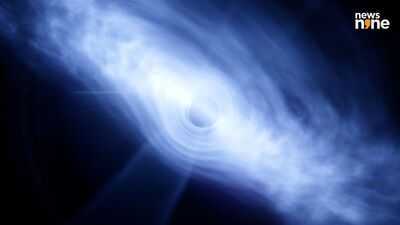
New Delhi: ISRO’s AstroSat mission has observed a mysterious X-ray flickering signal from a black hole designated as GRS 1915+105, located at a distance of 28,000 lightyears from the Earth. The black hole alternates between bright and dim phases, each lasting several hundred seconds, with the flickering detected primarily during the bright phases. The stellar mass black hole is voraciously feeding on the outer atmosphere of a binary companion. The extreme friction in the tortured material falling inwards is glowing energetically, producing extreme heat and X-rays. Observing these x-ray emissions helps scientists better understand the extreme environment in the vicinity of the black hole.
The glowing disc of infalling material, or the corona of the black hole is becoming tighter or more compact during the bright phases, when the flickering is the strongest. In the dim phases, the black hole corona cools and expands, causing the flickering to disappear. The signals indicate an oscillating corona, indicating that this is not a fixed structure, and can change its shape and energy depending on the flow of gases falling into the black hole. The observations also provide hints at how the supermassive black holes can influence entire galaxies around them. A paper describing the findings has been published in the Monthly Notices of the Royal Astronomical Society.
Unique capabilities of AstroSat made observations possibleSantabrata Das from the Department of Physics at IIT Guwahati says, “We have found the first evidence of rapid X-ray flickering, repeating nearly 70 times per second (∼70 Hz), occurring during the high-brightness phases of the source. Interestingly, these fast flickers disappear during the low-brightness phases. This new understanding was made possible by AstroSat’s powerful unique observational capabilities.” Another author of the paper, Anuj Nandi from URSC added, “Our study provides direct evidence for the origin of X-ray flickering. We have found that this flickering is linked to modulations in the corona surrounding the black hole.”